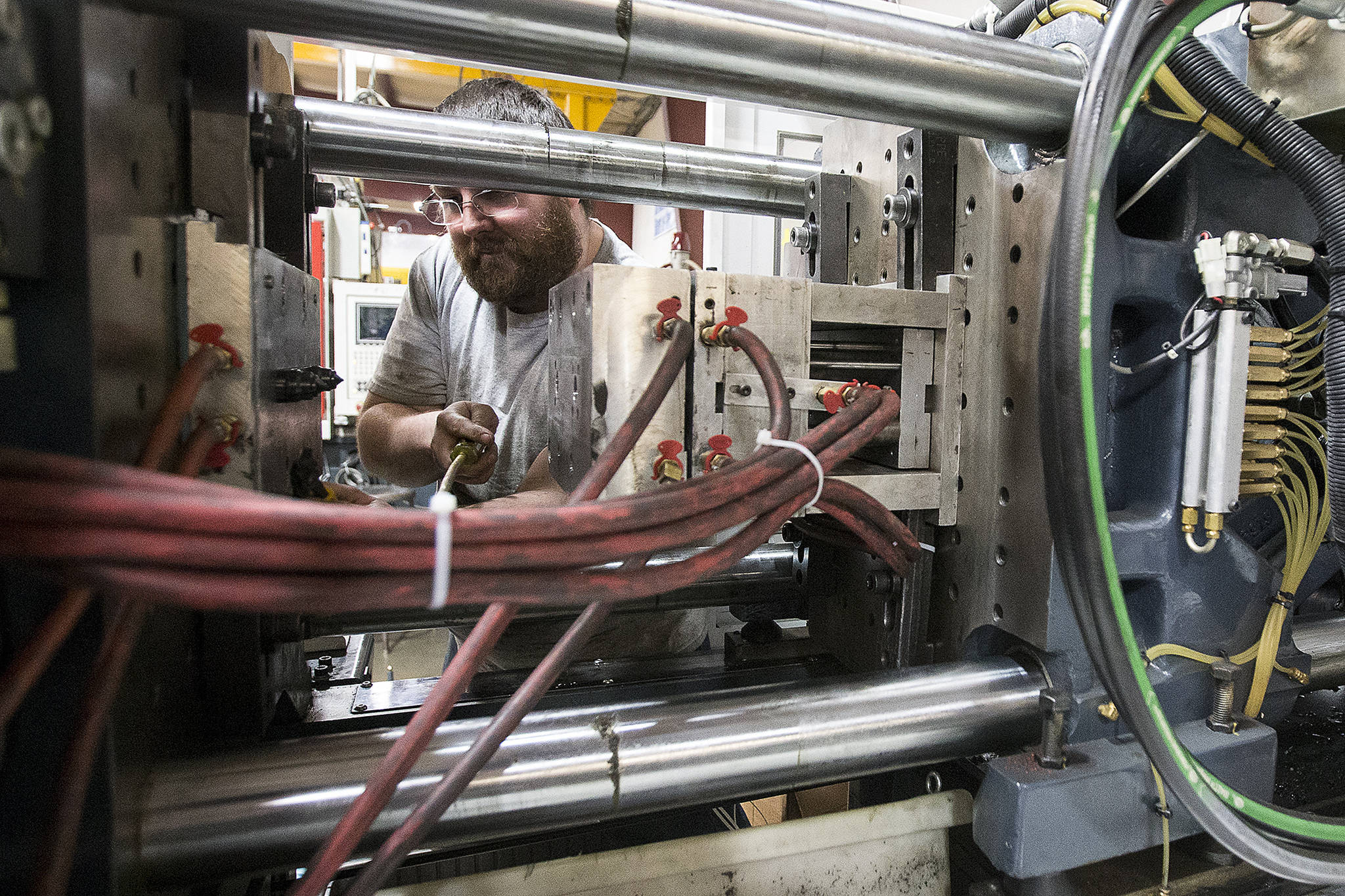Matt Poischbeg had a problem.
A veteran mold maker was about to retire from Everett’s Sea-Lect Plastics, and its vice president and general manager could not find a replacement.
Poischbeg advertised everywhere. He even hired a headhunter. Nothing.
Mold-making is critical for Sea-Lect, which uses plastic injection to produce millions of parts for kayaks, Navy ships and other vessels. It’s not a stretch to say the company’s future hung in the balance.
“I was in a panic mode,” Poischbeg said.
Desperate, he embraced a familiar solution: apprentices. “I’m from Germany,” he explained. “I know apprenticeships work.”
Four years later, they seem to be working well indeed.
The State Department of Labor & Industries hooked Poischbeg up with the Aerospace Joint Apprenticeship Committee, a state-funded nonprofit that offers apprenticeships in the aerospace and advanced-manufacturing industries.
Now Sea-Lect employs five AJAC apprentices, who work full time and attend training classes; the company also has a youth apprentice at Snohomish High School. Three other apprentices began the training but left the program for various reasons.
“I don’t think enough people know about apprenticeship programs,” said Rob Ferguson, a Sea-Lect journeyman toolmaker who mentors two apprentices and teaches AJAC classes at Glacier Peak and Arlington high schools. “There’s a lot of really great trades you can learn through apprenticeships, and you can have a career. Not just a job, but a career.”
For students, who can begin training as young as 16, AJAC apprenticeships provide a full-time job with benefits, plus four hours of classes a week. For Sea-Lect, apprenticeships provide potential long-term workers at low initial cost.
Apprentices begin at 60 percent of the average state journeyman level wage for their trade, and get pay increases every six months until they reach full-time salary. (The national average annual salary for all manufacturing workers is about $77,000, according to 2016 data from the Manufacturing Extension Partnership.)
AJAC pays tuition throughout the four- or five-year apprenticeship programs. Sea-Lect reimburses other school fees, paying students about $270 apiece per semester if they maintain high grades.
At the end of their training, the former apprentices can join Sea-Lect as full-salaried workers, if they choose. But, like free-agent athletes, they are free to test the market.
“Most people say, ‘I’m just training people for my competition,’” Poischbeg said. “But if everybody trains, we all benefit.
The Everett and Snohomish school districts are among six in the state that offer apprenticeship opportunities for high school students. So does the Sno-Isle Tech Skills Center, which serves students from 14 local school districts.
Nathan Hall, a 2017 Snohomish High School graduate, began apprenticing at Sea-Lect eight months ago. He just finished making his first mold.
“I was pretty excited to get to do something new every day, something challenging every day,” Hall said. “There’s a lot of math, a lot of thinking inside out. This makes school seem easy.”
Brett Muller, a third-year tool-and-die maker apprentice, chose Sea-Lect over an electrician apprenticeship.
“It was a better option. ‘What do you have to lose?’ is the way I look at it,” he said. “Would you like to earn money and learn a job at the same time? If it dries up tomorrow, I won’t lose anything.”
Asked if he’d like to work at Sea-Lect when his apprenticeship ends, Muller said, “maybe.” It’s a risk his boss is willing to take.
Poischbeg cites a study by Stefan Wolter of the University of Bern that shows most companies experience a net zero cost to train apprentices. Higher employer costs the first half of the apprenticeship are offset by higher worker productivity during the second half.
Apprenticeships could even prove profitable, the study claims, because apprentices perform better work as they gain skills, while their salaries remain below market value until the end of their apprenticeships.
And if employees wind up hiring their apprentices, it reduces turnover and promotes loyalty.
“It’s a different mindset,” said Poischbeg, 54, who served a pair of apprenticeships in Germany before attending college at age 29. “There’s no guarantee someone is going to stay forever, but that hasn’t held me back from investing.”
Poischbeg pitches in more than money. He speaks frequently about apprenticeships at industry conferences and in TEDx videos, and serves on a local committee to promote STEM education. Eventually, he said, he would like to see U.S. schools offer dual-track college and vocational degree programs, modeled after Europe.
“Our workforce is aging. Our skills shortage is not going to go away,” Poischbeg said. “We have a problem, and we have to fix the problem now. We need to build on this.”
Talk to us
> Give us your news tips.
> Send us a letter to the editor.
> More Herald contact information.

























